One additional step that I do is to use the drill bit to round out the hole simulating a sheave where the line goes around it and not straight through to present a more visual and practical means for the line to both enter and leave, (the fall). I do it for both upper and lower holes so that I don't have to think about the correct placement of the block for the running rigging. Just a thought. Rich (PT-2)I agree. I'll also usually run a fine drill bit through the block hole before I try and ram through a thread.
You are using an out of date browser. It may not display this or other websites correctly.
You should upgrade or use an alternative browser.
You should upgrade or use an alternative browser.
How do I get a .8mm rigging line into a 4mm block with one hole? This is for a Mizzen Topgallant Stay(See Rigging Diagram
For cleaning and also widening holes in wood I use so called reamers / broaches (in german "Reibahle")
They have 5 edges and are available from very small diameter
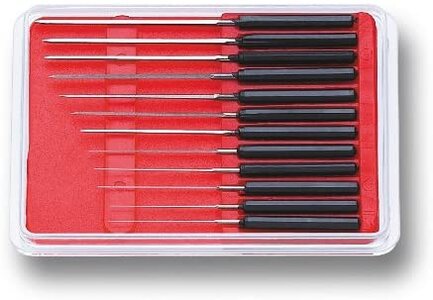
This set has 12 pieces from 0,05 - 0,55 mm
Other sets
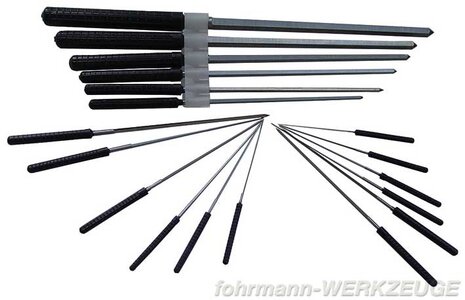
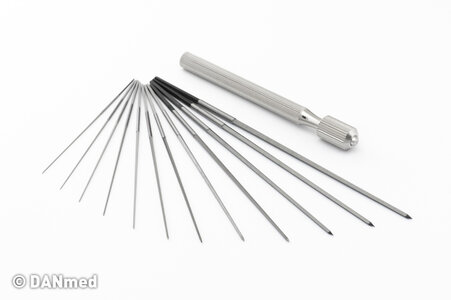
also very helpful is the fact, that they are very long (appr. 3 to 5 cm (depending on the diameter.
I made f.e. the holes of my scuppers with them
First drill 0,5mm with a drill and than widening with the streamers until a needle file is possible -
everything by hand and no power tools -> so I have everything under control
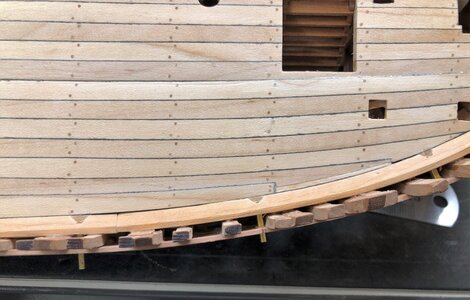
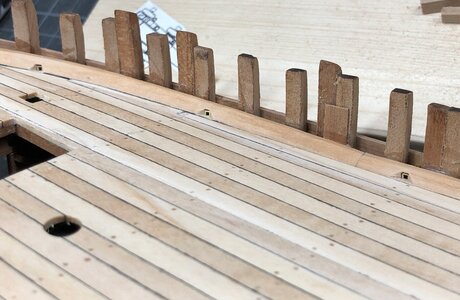
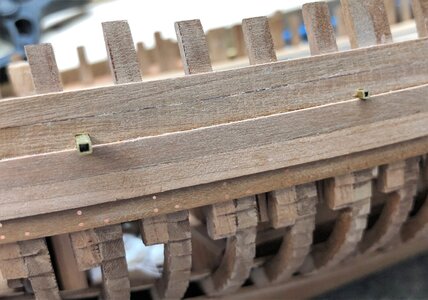
They have 5 edges and are available from very small diameter

This set has 12 pieces from 0,05 - 0,55 mm
Other sets


also very helpful is the fact, that they are very long (appr. 3 to 5 cm (depending on the diameter.
I made f.e. the holes of my scuppers with them
First drill 0,5mm with a drill and than widening with the streamers until a needle file is possible -
everything by hand and no power tools -> so I have everything under control



I have been going through this forum with great interest as I have the same challenges...small sheave holes that are a part of the block, which may or not be the correct size and a rope indication that may also be the wrong size. The advice given through this forum is great advice for both the rope and the block. But, I have what might be considered a 'third' question: how do you hold a 2, 2.5, 3, or 3.5 mm. block so that you can get the mini drill bit through to enlarge the sheave hole to accept the 'frozen' rope? I have tried the following: fingers...not good for me as I am a bit ham-handed; hemostats...the smaller blocks seem to crush too easily: clips or pincers of varying sorts...hmmm! when the block flips out of a clip, it takes off light a jumping bean, never to be seen again. (I am very glad for Dry Dock blocks). However, and a bit more seriously, what is the secret to holding those little things firmly enough to adjust the size without ruining or losing them?
I am not sure if you shared very much with how you prepare the block sheave upper and lower holes fairing them to assist in the smooth entry and fall of the line. Then, no matter what the line size is, I always rub and twist the end in the direction of handing, with carpenter's alephatic glue to stiffen it before cutting it at an angle creating a stiff needle to pass through the block. Oh yes, I also pull the line across my bees wax block and pass it several times through my fingers, "melting' or setting the wax into the line which also reduces any fuzziness. As to tightening the line through the block it can be a challenge not to pull something out of place so I use small tweezers coaxing the line a bit at a time through as well as pinching the entry and exiting fall onto the sheave portion of the block. No fast way that I know of but having prepped the block holes larger and faired for the radiused sheave is a critical step. Best of luck as you experiment and proceed. Rich (PT-2)I have been going through this forum with great interest as I have the same challenges...small sheave holes that are a part of the block, which may or not be the correct size and a rope indication that may also be the wrong size. The advice given through this forum is great advice for both the rope and the block. But, I have what might be considered a 'third' question: how do you hold a 2, 2.5, 3, or 3.5 mm. block so that you can get the mini drill bit through to enlarge the sheave hole to accept the 'frozen' rope? I have tried the following: fingers...not good for me as I am a bit ham-handed; hemostats...the smaller blocks seem to crush too easily: clips or pincers of varying sorts...hmmm! when the block flips out of a clip, it takes off light a jumping bean, never to be seen again. (I am very glad for Dry Dock blocks). However, and a bit more seriously, what is the secret to holding those little things firmly enough to adjust the size without ruining or losing them?
Maybe such a device can help you. You only need to clamp the block in another placeI have been going through this forum with great interest as I have the same challenges...small sheave holes that are a part of the block, which may or not be the correct size and a rope indication that may also be the wrong size. The advice given through this forum is great advice for both the rope and the block. But, I have what might be considered a 'third' question: how do you hold a 2, 2.5, 3, or 3.5 mm. block so that you can get the mini drill bit through to enlarge the sheave hole to accept the 'frozen' rope? I have tried the following: fingers...not good for me as I am a bit ham-handed; hemostats...the smaller blocks seem to crush too easily: clips or pincers of varying sorts...hmmm! when the block flips out of a clip, it takes off light a jumping bean, never to be seen again. (I am very glad for Dry Dock blocks). However, and a bit more seriously, what is the secret to holding those little things firmly enough to adjust the size without ruining or losing them?
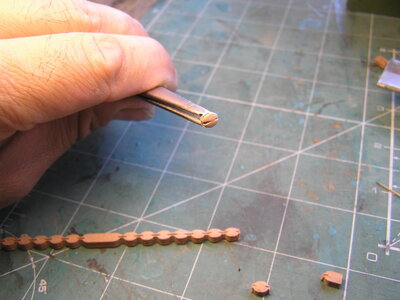
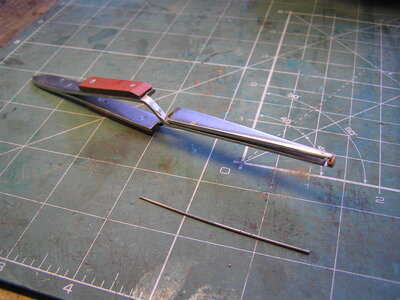
I recognize the making of blocks and holding device made by Dmitry Shevelev, Am I correct, Sasha?Maybe such a device can help you. You only need to clamp the block in another place
Dima, you are surprisingly perceptive.I recognize the making of blocks and holding device made by Dmitry Shevelev, Am I correct, Sasha?
 Yes, this is Dima Shevelev's development
Yes, this is Dima Shevelev's developmentThanks, Alexander
Making or adjusting a special tool never occurred to me. The adjustment to the tip of the tweezers is a superb idea. Thanks, again.
Maybe I'll get to move from Seaman Apprentice to Seaman after all. Coming back to ship modeling after about forty or so years has been a bit daunting at first, but truly great fun getting back to the books, plans, and the like.
I am currently working on the Mayflower from the old Revell kit with some adjustments based on the old Airfix model as described in Noel Hackney's Classic Ships book. We'll see how that works since nobody seems to have a copy of the Airfix kit's instructions.
PeeGee
Making or adjusting a special tool never occurred to me. The adjustment to the tip of the tweezers is a superb idea. Thanks, again.
Maybe I'll get to move from Seaman Apprentice to Seaman after all. Coming back to ship modeling after about forty or so years has been a bit daunting at first, but truly great fun getting back to the books, plans, and the like.
I am currently working on the Mayflower from the old Revell kit with some adjustments based on the old Airfix model as described in Noel Hackney's Classic Ships book. We'll see how that works since nobody seems to have a copy of the Airfix kit's instructions.
PeeGee
You took the words out of my mouth, I agreed 100% with that idea because that is exacltly what I also do. (Drill a larger hole.)I have figured out to get the .8mm rigging line through the hole in the block. Two elements. First drilling a larger hole. I have a vise where I can place the block. Then I use a dremel with a smaller bit to enlarge the hole and use a larger bit to get to the right hole size. Second. I use glue to stiffen the end of the .8mm line , cut the end in an angle and just put the line through the hole. Thanks for all your suggestions!
Excuse me for being pedantic in my confusion of terminology: as I understand "blocks" are wooden surrounds for internal sheaves (grooved wheels) for reduced effort in passing lines in a changed direction of travel, often 180 deg. While a solid, non-rotating devise with one opening is often a "thimble" or "Heart" depending upon actual shape, which are often used at the end eye spliced into a line through which a line passes that does not frequently change setting as with sheets for example.You took the words out of my mouth, I agreed 100% with that idea because that is exacltly what I also do. (Drill a larger hole.)
In either case it may be necessary to enlarge the holes in typical blocks, single, double, triple, or quad sheaves, above and below the simulated sheave inside. In any case "fairing" the holes on each side is necessary for a rounded entry and exiting fall of the line in a smooth radius and not being forced around a square hole edge.
Just some thoughts. Rich (PT-2)
It is important to keep an eye on the basics. The ratio between the rope and the sheave diameter is in British ships 1:5, in Americans 1:6 so let's take the 1:5 ratio as a minimum. A 4 mm block can accommodate not bigger than 2.5 mm (but definitely less than 3 mm) sheave so the thickest line a 4 mm block can handle is not bigger than 0.5 or in extreme case 0.6 mm rope. So getting back to the original comment I believe an 0.8mm rope is well oversized to a 4 mm block.
János
János
This information seems to talk about sheaved blocks and not the single hole block that was initially posed for help. I do appreciate the guidelines though and will make a note of those for the future. Rich (PT-2)It is important to keep an eye on the basics. The ratio between the rope and the sheave diameter is in British ships 1:5, in Americans 1:6 so let's take the 1:5 ratio as a minimum. A 4 mm block can accommodate not bigger than 2.5 mm (but definitely less than 3 mm) sheave so the thickest line a 4 mm block can handle is not bigger than 0.5 or in extreme case 0.6 mm rope. So getting back to the original comment I believe an 0.8mm rope is well oversized to a 4 mm block.
János
- Joined
- Aug 8, 2019
- Messages
- 4,063
- Points
- 688

I made a table with dimensions of the blocks and ropes compared to each other. It's made to the info of Mondfeld. It gives exactly the measurements. So to find your block you need for example:
a rope 0,5 mm gives a block of 4,68. In the shop they don't sell 4,68 mm blocks so take a 5 mm block.
translation
Touw is rope
Schijf is sheave
schijfgat is sheave hole
strop is strap
juffer is deadeye
dikte is thickness
hoogte is height
breedte width
see attachment
a rope 0,5 mm gives a block of 4,68. In the shop they don't sell 4,68 mm blocks so take a 5 mm block.
translation
Touw is rope
Schijf is sheave
schijfgat is sheave hole
strop is strap
juffer is deadeye
dikte is thickness
hoogte is height
breedte width
see attachment
Attachments
Many thanks, Stephan! Even it is not an English language it is pretty much self-explanatory and will be a great help to others. 




